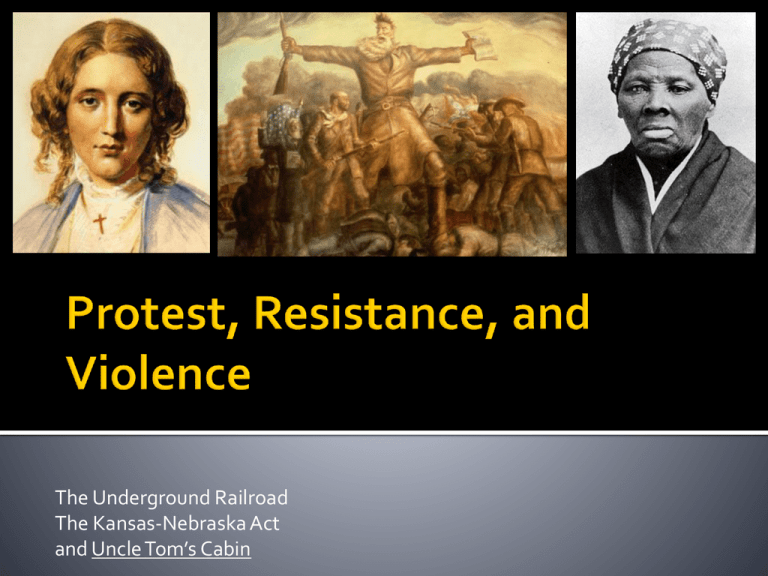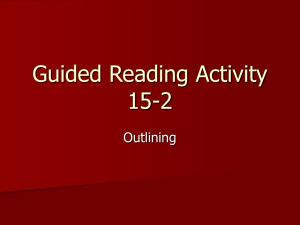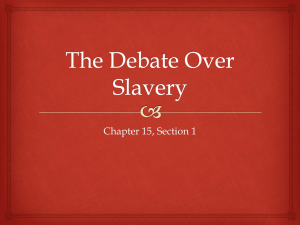
The Underground Railroad
The Kansas-Nebraska Act
and Uncle Tom’s Cabin
To understand the Fugitive Slave Act and the reaction
of Northern abolitionists to this law.
To understand how violence erupted in Kansas, as
well as Senate, due to slavery.
To understand what popular sovereignty meant for
the future of the nation, as well as Douglas’s
involvement in turning over the Missouri
Compromise.
Key Terms: Fugitive Slave Act, Underground Railroad,
and Kansas-Nebraska Act
The Fugitive Slave Act surprised many people due to the harsh
terms which would not allow fugitives to a trial or the right to
testify on their own behalf.
Read the passage on pg. 311, by Frederick Douglass.
Anyone convicted of helping an alleged fugitive could receive a
$1,000 fine, six months in prison, or even both.
Northerners resisted the fugitive slave act
through protests, legal matters, and
violence. The personal liberty laws
guaranteed fugitives a trial, which lawyers
would stretch out for several years.
Outraged Southerners found themselves
edging more and more towards a desire
for disunion.
Free slaves and white abolitionist joined forces in the north to create a
network of people who would aid fugitive slaves escape to freedom.
This network was known as the Underground Railroad, and the people
involved were known as “conductors.” The conductors would hide
slaves in tunnels and false cupboards, and then pass the fugitives on to
the next safe house.
Harriet Tubman was one of the most famous
conductors, and reportedly traveled back to the South
19 times and rescued 300 slaves including her own
parents.
To escape from slavery, fugitives needed to travel at
night with only the North Star to guide them. They had
to avoid patrols of armed men on horseback and
struggled to get food.
Some slaves remained in the North once free while
others went on to Canada.
In 1852, Harriet Beecher Stowe published her pro-abolitionist novel
Uncle Tom’s Cabin in which she depicted slavery as more than a
political debate, but rather as a great moral struggle.
The novel created a stir in both the North and South, and increased
the protests against the Fugitive Slave Act in the North while being
banned in the South.
This book was thought to “galvanize” or excite
(as if by electrocution) the entire nation.
And now a quick quiz…. Take out a fresh piece of paper!
1) How was Tom and Legree depicted in the excerpt you read? Use
adjectives to describe them, as well as explaining why you think
Stowe depicted them the way she did.
2) What symbolism or imagery did you find in the story? Think about
the title “The Martyr”
Stephen Douglas intensified the issue of slavery when he supported the
Southern bill to repeal the Missouri Compromise, in an effort to further
his own interests in running a railroad line from Chicago to California.
Douglas’s bill separated the unorganized territories into Nebraska and
Kansas, each would be given popular sovereignty, thus repealing the
Missouri Compromise.
Douglas honestly believed that popular sovereignty was the democratic
way of solving the issues of slavery. He was mistaken in how the public
would react.
Northern congressman saw the plan as a plot to turn the
territories into slave states, and 90% of southern
congressman voted for the bill.
With the help of President Pierce, the Kansas-Nebraska Act
became a law in 1854, and many questioned what the
outcome would be for these territories.
Kansas became a competition between the North and South to see
who could claim the state first. Both sides were armed with the needs
of farmers, but also many were equipped with rifles.
When it came time to vote, “border ruffians,” from Missouri illegally
voted in the poll and allowed for the state to be claimed for slavery.
Violence erupted when an anti-slavery town (Lawrence) was sacked by
proslavery militia.
In response to this act, John Brown attacked the settlement
a Pottawatomie Creek and cut the hands off 5 men before
stabbing them through with broad swords.
Kansas became known as “Bleeding Kansas,” due to the
dozens of incidents that broke out throughout the state after
John Brown’s actions. Over 200 people were killed in this
mini-civil war.
A very odd moment in history occurred in the Senate in 1856, when Charles Sumner
was attacked by Preston Brooks with a cane for slandering his uncle (Sen. Andrew
Butler of SC) for a speech impediment.
Sumner did not return to Congress for three years and suffered apparent brain
damage from the beating.
HW: SpNotes Ch10.3
You should start working on your research
project rough drafts. Due on the 22nd!
Push in your chairs and clean up!
Have a great day!












